-
Understanding seabird and whale distributions and populations from a big boat
Posted on December 15th, 2021 No commentsMegan Cimino, Ross Nichols, Megan Roberts, Darren Roberts
During this research cruise, the whale and seabird teams mainly spend the day on the ship’s bridge recording all seabird, seal and whale species. Because we are in Antarctica during the spring, there are very few hours of darkness, roughly midnight to 3 am. Therefore, the seabird team members – Megan and Megan – work in shifts, one person working in the early morning to midday and one member working midday to midnight. We have seen a variety of seabirds ranging from large albatross (the size of a small dog) to tiny storm petrels (the size of a hamster).
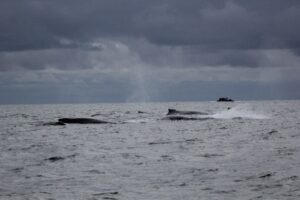

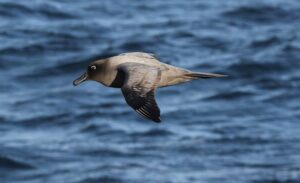
When the ship is near important penguin breeding colonies, the seabird researchers take a small boat to shore to count the number of nesting penguins to understand how their populations change over time in response to environmental conditions. A few days ago, team counted nearly 10,000 penguins in 7 hours using hand clickers, which required hiking over 6 miles in snowy and windy conditions. At this time of year, the penguins are beginning to lay and incubate their eggs that will hatch in late December.
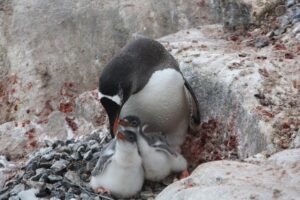
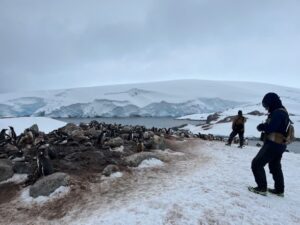
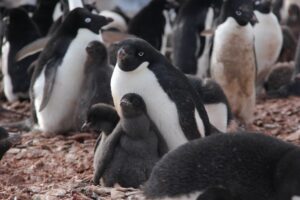
When a feeding and slow-moving group of whales are spotted from the ship, this provides an opportunity for the whale researchers – Ross and Darren – to go out in a small zodiac boat to take pictures and other biological samples. Pictures of whale flukes allow scientists to identify individual whales because their fluke is similar to a human’s fingerprint- everyone is unique! This allows us to estimate individual animal movements and population size. Small samples of the animal’s blubber can be used to determine if a whale is male or female, and can also identify if a female is pregnant. By monitoring the ratio of males to females and the rates of pregnancy, we can assess the health and growth of whale populations.
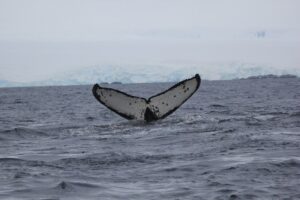
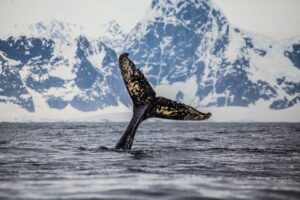
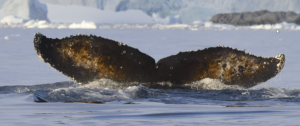
Identify a Whale! Can you tell these whale flukes apart?
These observations and samples are important because seabirds, seals, and whales are the major predators in Antarctica. These indicator species can tell us a lot about the health of the ocean’s ecosystem. It is difficult to know how many fish and krill are in the Southern Ocean but we can learn a lot by studying the health of larger animals that feed on them. Changes in the health of the animals or changes in species observed can tell us how the ecosystem is changing, especially in the context of climate change. As temperatures are warming rapidly in this polar region, it is very important to understand how these animals are responding to these changes to learn more about the overall health of our oceans.
-
RUCOOL Updates: October-November 2021
Posted on December 15th, 2021 No commentsAnd just like that, we are approaching the end of 2021. It was good to see students back in the classroom and labs, on beaches and boats, and even traveling south for summer research in Antarctica.
State
- Our 3rd cohort Masters of Operational Oceanography students have almost completed their first semester, which actually started in early August with software and glider training. This fall, in addition to classes and lab work, they have been on glider deployments and recoveries as well as HF-Radar site visits.
- The NJDEP Commissioner, Shawn LaTourette, along with Bob Schuster and Megan Brunatti visited COOL in October. Discussions focused on offshore wind development, climate resilience and improving coastal water quality. Shawn posted a video of his visit.
- The New Jersey Board of Public Utilities (NJBPU) and the New Jersey Department of Environmental Protection (NJDEP) visited RUCOOL in November. The attendees are active in the state’s development of 7.5 GW of offshore wind, as part of its goal to have 100% clean energy by 2050. Several representatives from each agency participated on a career panel with students in the Topics of Marine Sciences class, discussing their diverse career paths that led to their current positions with the state, and the myriad ways that today’s students might play a role in New Jersey’s blue economy.
- Grace Saba organized and hosted a virtual workshop on November 19th focused on Developing a New Jersey Statewide Ocean Acidification Monitoring Network.
- The R/V Rutgers engine issue was fixed by Captain Chip Haldeman. We expect the R/V Rutgers to head to Tuckerton for winter glider deployments and recovery support for Orsted and other projects.
- Our glider team continued a very busy fall in Oct/Nov supporting 11 deployments from the Gulf of Maine to the Jersey coast all the way down to the Caribbean. These gliders swam over 5400 kilometers and supported grants from NOAA, NSF, Orsted, NJDEP and the Vetelsen Foundation. It will be a busy winter of data analysis.
- The COOLroom and glider lab were once again open for visits and tours this fall, beginning in late October. Over 40 visitors from NJDEP, NJBPU, Bermuda, Chile, the NJ Wind Institute and Rutgers Open House toured COOL
- RUCOOL welcomed back Dean Robert Goodman to the COOLroom for a ceremony adding a plaque in his name to our RUCOOL Wall of Fame. The plaque states “For acting on his vision of new academic paradigms, empowering generations of ocean explorers to build and apply ocean observing networks that advance our science and support a global community embarking on a new blue economy.”
National
- Scott Glenn completed an active year co-leading the NOAA Science Advisory Board (SAB) efforts to meet its commitments to the U.S. Congress. Scott Glenn (academic oceanographer) and Brad Colman (industry meteorologist) co-chair the SAB’s Environmental Information Services Working Group (EISWG) and the SAB’s decadal Priorities for Weather Research (PWR) study. The PWR report, now approved by the full SAB and forwarded to the NOAA Administrator for submission to Congress, was a year-long study involving over 150 subject matter experts to define Federal investment priorities in weather research and forecasting. The PWR report identifies 11 priority areas, 33 high-level recommendations and 102 critical actions for investment that, taken together, will transform U.S. Earth System forecasting and promote a more Weather Ready Nation that includes historically underserved and socially vulnerable communities. The PWR report is now being used to help inform the largest increase in NOAA’s budget since its formation over 50 years ago. The EISWG’s 2021 annual Report to Congress (RtC) on NOAA progress implementing The Weather Research and Forecasting Innovation Act of 2017 (“The Weather Act”) was approved by the SAB and forwarded to the NOAA Administrator for submission to Congress. The RtC includes the EISWG review of the NOAA Hurricane Forecast Improvement Program (HFIP) led by Scott Glenn.
- The hurricane season came to a conclusion at the end of November. Through NOAA funding, our team was involved with numerous glider deployments and a US team measuring the impacts of the storms on the ocean and vice versa throughout not only the mid Atlantic, but the southeast coast, Gulf of Mexico and Caribbean as well. Our HF-Radar team tracked the eye of Ida off NJ and Long Island, showing the National Weather Service’s estimated eye track was a few miles east of the true storm center. It will be a long winter of data analysis as we work to improve hurricane forecast intensity models.
- RUCOOL Post-doc Jessica Valenti presented her research “Microplastics in the Marine Food Web: Insights from a Larval Fish Collection” at the Coastal and Estuarine Research Federation virtual meeting (oral presentation) and the American Fisheries Society meeting in Baltimore, MD (poster).
- PhD student Emily Slesinger gave an oral presentation titled “Interaction between shifting fish distributions and migration distances on reproduction: a case study with black sea bass” at the American Fisheries Society meeting in Baltimore, MD.
- The RUCOOL Education Team received $750,000 from NSF to develop online tools to help university researchers connect their research with society. Their new toolkit will support scientists, engineers and other researchers in planning and developing education and outreach projects that support and explain their work.
- Oscar Schofield reappointed to the Federal Advisory Committee overseeing the US Integrated Ocean Observing System
International
- Oscar Schofield Chaired a National Academy of Sciences and Medicine Study entitled “Mid-Course Assessment of NSF progress on 2015 Strategic Vision for Antarctic and Southern Ocean Research”.
- Rutgers has been participating in the NSF’s Long-Term Ecological Research (LTER) project at Palmer Station Antarctica for over 30 years. Graduate students Quintin Diou-Cass and Joe Gradone boarded the R/V Nathaniel Palmer to head to the West Antarctic Peninsula. We wish them all well for their summer Southern Ocean exploration.
Newly Funded Research
- University of Delaware through NOAA IOOS, “Mid Atlantic Regional Association Coastal Ocean Observing System,” Schofield & Crowley ($1,108,577, 1 year). First of two parts.
- State of NJ Department of Environmental Protection, “Glider deployments for water quality monitoring,” Kohut ($84,464, 1 year).
- CODAR Ocean Sensors, “Wind Turbine Interference Mitigation Data Backfill,” Roarty ($24,885, 1 year).
- National Science Foundation, “Implementation and Evaluation of the ARIS Broader Impacts Toolkit,” McDonnell ($749,866, 3 years).
- Rider University through the National Science Foundation, “Improving Undergraduate Scientific Explanations: Exploring the Role of Data Literacy Skills in Scientific Reasoning,” Lichtenwalner ($19,099 for 1 year).
Papers Published: (**Current or Former Graduate Student or Postdoctoral Researchers)
- Miles, T., S. Murphy, J. Kohut, S. Borsetti, and D. Munroe (2021), Offshore wind energy and the mid-atlantic cold pool: A review of potential interactions, Mar. Technol. Soc. J., 55(4), 72–87, DOI:10.4031/MTSJ.55.4.8
- Schofield, O. (Chair), Barger, A., Brunt, K., Clauer, R., Das, I., Detrich, W., Gooseff, M., Halanych, K., Halpern, M., Murray, A., Rignot, E., Shevenell, A., Takai, H., Wilson, T., Wolff, E. National Academies of Sciences, Engineering, and Medicine. 2021. Mid-Term Assessment of Progress on the 2015 Strategic Vision for Antarctic and Southern Ocean Research. Washington, DC: The National Academies Press. DOI: 10.17226/26338
- Roarty, H. (2022), Measuring Currents with High Frequency Radar, Eldridge Tide and Pilot Book, 2022
Public Media
- RUCOOL’s Travis Miles and DMCS’ Daphne Munroe were interviewed by WHYY for an article entitled “Jersey Shore’s fishing industry wonders: Can it coexist with planned massive wind farms?”
RUCOOL Meetings & Conferences
RUCOOL continues to lead/attend numerous virtual meetings. Here are some meetings which our team attended and/or presented: MARACOOS Board Meeting, Coastal and Estuarine Research Federation Meeting, American Fisheries Society Meeting, Supporting OA Action Planning and Implementation in the Mid-Atlantic Workshop, Integrated Ocean Observing System Annual Meeting, Hudson River Foundation Continuous Monitoring Practitioner Meeting, Underwater Glider International User Group Meeting, Cakefest PHP Meeting, NJ EDA Wind Institute Meeting.



